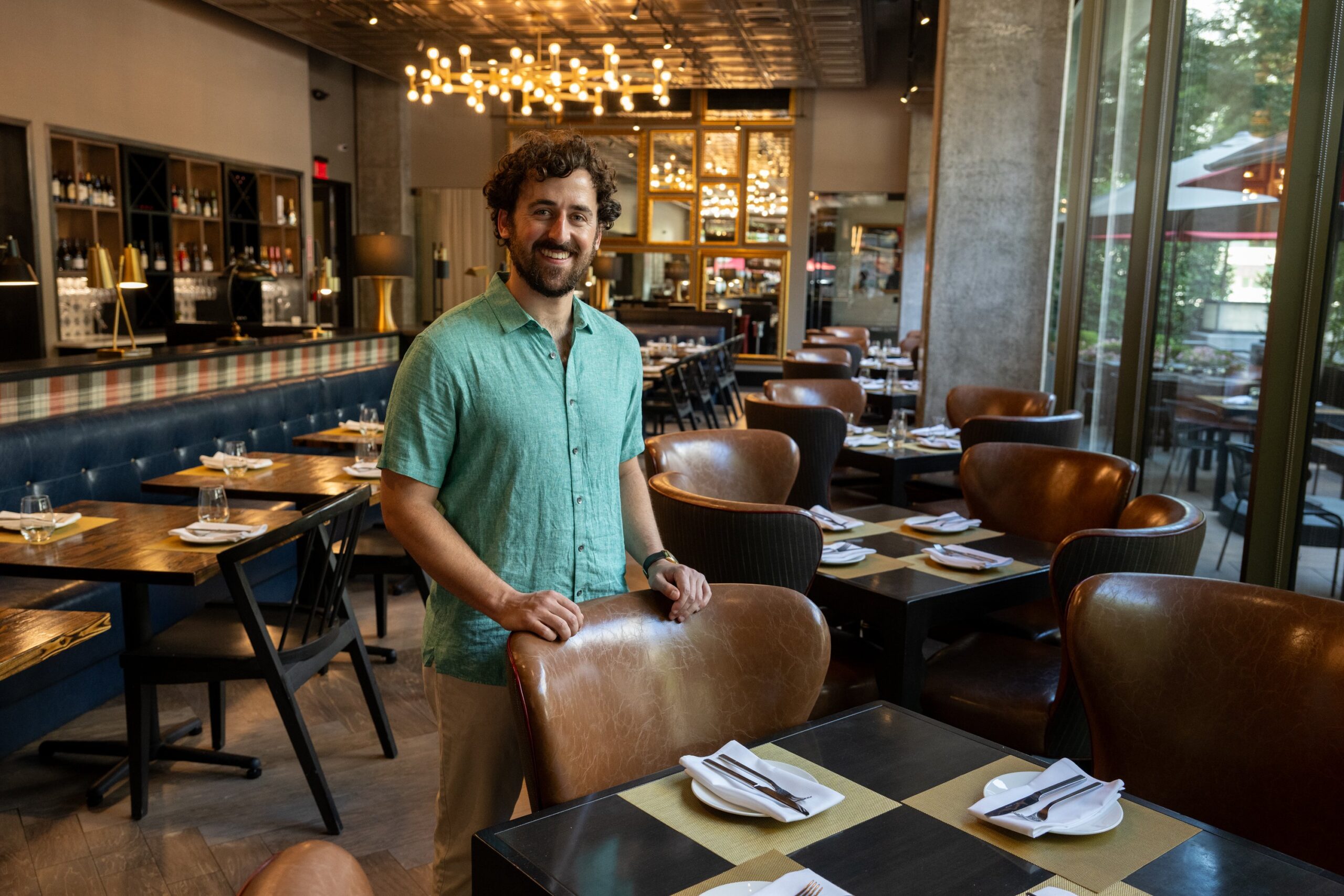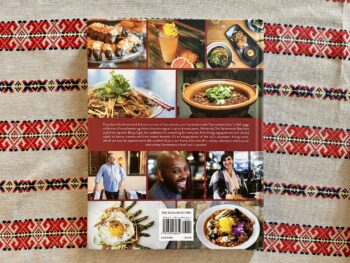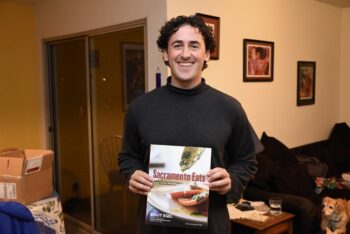4 audience-first takeaways from The Sacramento Bee’s restaurant cookbook strategy
Benjy Egel, The Sacramento Bee,
Food and drink reporter Benjy Egel appears in Camden Spit & Larder in a photo from The Sacramento Bee's new cookbook, "Sacramento Eats: Recipes from the Capital Region's Favorite Restaurants". (The Sacramento Bee)
Here’s an idea to steal and adapt: How to create a regional keepsake that drives revenue toward your newsroom.This is a series on Better News to a) showcase innovative/experimental ideas that emerge from the Knight-Lenfest Newsroom Initiative and b) share replicable tactics that benefit the news industry as a whole.
This “win” comes from Benjy Egel, food and drink reporter at The Sacramento Bee, which is part of the McClatchy Media Network. The Sacramento Bee participated in the Major Market Table Stakes program in 2018 and the Gannett-McClatchy Table Stakes program in 2019-20.
I was born in Sacramento, but left as I entered college and started my first job in news in Texas. When I returned in 2017, the food world’s embrace of locally-sourced ingredients and celebration of diverse cuisines, combined with the Bay Area’s astronomical cost of living, had turned what was once a sleepy government town into a burgeoning dining destination. I became The Sacramento Bee’s food and drink reporter in 2018 and spent the next five years closely watching as the culinary scene continued to mature, attracting Michelin stars and James Beard Award nominations. Meanwhile, my reporting drove more than 1,000 new subscribers to The Bee as local readers showed their appetite for day-in, day-out reporting on the city’s new cultural heartbeat. Ambitious projects such as a review-based list of the region’s top 50 restaurants proved especially fruitful.
Sacramento’s food scene was having its moment, but it still felt lost in the Bay Area’s shadow. Even though the highest-end restaurants and those in the heart of the city garnered outside attention, I believe modern Sacramento dining is defined in part by the region’s fantastic yet affordable neighborhood eateries. I also knew that Sacramentans love their local restaurants and would want to make certain favorite dishes at home – or find a new destination for a night out. I set out to write “Sacramento Eats: Recipes from the Capital Region’s Favorite Restaurants”, for two reasons: to show that greater Sacramento can stand on its own as a dining destination if one knows where to look, from the prix-fixe special occasion places to the scrappy soul food joints, and to amass a one-of-a-kind guide for local gastronomes to experience the city’s foods in the comfort of their own homes.
The result is a collection of recipes from 60 local restaurants and bars, each listed with its address, phone number, website and a one-paragraph summary of what makes it special. “Sacramento Eats” debuted on Nov. 17, retailed for $39.95 and sold all 3,000 printed copies by Dec. 6. At least 1,700 more copies will be printed in January 2024.

“Sacramento Eats: Recipes from the Capital Region’s Favorite Restaurants” highlights the Sacramento region’s diverse, ascendant culinary scene (The Sacramento Bee)
Community engagement and reporting that built trust
What we did and why: I spent the five years leading up to the launch of “Sacramento Eats” covering Sacramento restaurants and bars — writing not just about their openings and closings, but producing deeply reported, exclusive pieces on how a cafe’s fruit trees were a symbol of strength in the face of racism and how a chef tried to take his own life and survived, spurring a personal transformation that led to his restaurant earning a Michelin star. Had I not built and developed professional relationships with many of these restaurants, they might not have entrusted me with their recipes.
What worked well: Getting restaurants to share their recipes was surprisingly easy. Only three or four said no, and those that participated in the book have been really helpful with publicity after its release. They shared the book with their followers, joined me for release parties and ordered dozens of copies for their staffs.
What didn’t work as expected: Thanks to my prior relationships, it was easy to call chefs and get them to say “yes” to submitting recipes. Follow-through proved more difficult. Nearly all the chefs blew through the deadlines I gave them, whether short or long, and about 20-30 chefs verbally committed to submitting a recipe but never sent one in despite follow-up messages.
Try this: Start early! The better your connection before making this ask, the more likely a chef is to part ways with a flagship recipe. The sooner you ask before your deadline, the easier it is to work around chefs who don’t follow through.

Food and drink reporter Benjy Egel holds The Sacramento Bee’s new cookbook, “Sacramento Eats: Recipes from the Capital Region’s Favorite Restaurants” (The Sacramento Bee)
Meeting audiences where they are with the information they want
What we did and why: It wasn’t just sources who knew me prior to writing “Sacramento Eats.” The Bee and I intentionally cultivated my brand as the preeminent expert on the Sacramento area’s restaurant and bar scene during the past five years. My weekly newsletter, which is repackaged as a column online and in print, is a major part of that. Each newsletter begins with a short local food/drink news story, followed by a restaurant review, three openings/closings and a link to all of The Bee’s food/drink articles published in the last week. It has become a key part of our restaurant reporting, and with 7,000 newsletter subscribers and an open rate of about 40%, it gave The Bee confidence that I had enough of a following to make the cookbook successful.
What worked well: The Bee now has a built-in newsletter audience of 7,000 people who want my weekly food and drink content in their lives. Most of them enjoy exploring a range of restaurants around the Sacramento region, and many more enjoy cooking at home. They were the first people outside the newsroom to hear about the cookbook, a focused audience of diehards who were most likely to purchase “Sacramento Eats.” I also posted pictures from the cookbook on my social media platforms for my thousands of followers who spend more time on Instagram, Facebook and X than perusing The Bee’s stories, and several of them would comment when they placed their orders, which encouraged others to do the same.
Try this: Encourage people to pre-order copies as much as possible, as this determines how many copies the publisher will print. Reach out to other outlets for cross-promotion — our local NPR affiliate was happy to have me discuss Sacramento food trends, and always gave me an opportunity to plug my cookbook a bit at the end. When the book came out, I organized a media blitz in which I reached out to local TV stations and podcasts, as well as national outlets, because many readers said they were buying them for friends who once lived in Sacramento before moving elsewhere.

The cookbook gives home cooks a chance to replicate restaurant dishes while also affording businesses the chance to show off their flagship meals (The Sacramento Bee)
Partnering with Pediment Publishing
What we did and why: The Bee is set up to publish news, not a book. We needed another organization with the infrastructure to do so. Pediment Publishing is a Washington-based publisher that largely works with news outlets on similar projects. McClatchy had a preexisting relationship with Pediment, as I discovered after reaching out to pitch the book idea, and provided the support that proved essential in making the book what it is. Pediment paid McClatchy a $1,500 content fee once “Sacramento Eats” was published, and McClatchy receives 15-40% of book sale royalties depending on the number of copies sold and the mechanism. In total, “Sacramento Eats” is expected to net McClatchy more than $25,000.
What worked well: Pediment handled the cookbook’s layout and design, with input from The Bee, and printed and bound the hardcover books. It also took pre-orders and handled distribution, ran ads in advance of publication and got the books placed with Amazon and Barnes & Noble. My primary relationship was with the company president, Chris Fenison, who was extremely responsive and helpful.
What didn’t work as expected: Many booksellers work with a distributor called IngramSpark, as I learned, which makes ordering books from multiple publishers very easy. Pediment does not work with IngramSpark and instead chooses to process orders directly through its website, which requires a few extra steps. We’ve worked with some bookstores to overcome this issue by ordering books ourselves and acting as a middleman. However, some stores decided this workaround was too laborious and decided not to carry the book. The book’s degree of popularity also caught Pediment (and local bookstores) by surprise, and while Pediment will print more copies in January, we sold all the available stock in early December – a missed opportunity to capitalize fully on Christmas demand.
Try this: Know your publication’s limitations, and find a publisher that can fill in those gaps. But if you can, learn your publisher’s limitations up front as well, and determine what distribution you’ll need to do.

Local restaurants such as Ginger Elizabeth Chocolates are the focus of “Sacramento Eats: Recipes from the Capital Region’s Favorite Restaurants” (The Sacramento Bee)
Getting the newsroom onboard
What we did and why: Alvie Lindsay, McClatchy’s California investigative editor, asked all Sacramento Bee reporters to pitch “something ambitious” that we were passionate about at the beginning of 2023. I came to that pitch meeting with some preliminary research — a short list of publishers with whom I’d like to work and a few chefs who had already shared recipes elsewhere and might be amenable to doing so with The Bee. My editors loved the pitch and brought new ideas to the table that we’re implementing now, such as breaking recipes out to run individually in the newspaper.
What worked well: The Bee’s visuals editor assigned photographers to take pictures of the dishes and chefs, creating a visually stunning book and giving the newsroom fresh photos for the next time we publish a story about that restaurant. Executive Editor Colleen McCain Nelson assigned Managing Editor Scott Lebar to edit my book introductions and the write-ups of each restaurant in “Sacramento Eats” and then tasked three summer interns with fact-checking it. McClatchy has purchased 100 books so far for me to sell to local bookstores and markets, which proved invaluable when bookstores sold out of available copies during my book signings. Our audience team helped create a digital presence and awareness, as well as developing QR codes for book purchases, newsletter signups and subscription sales at my book signings.
What didn’t work as expected: Staff photographers were crucial to the success. Originally, though, we had anticipated that we would be able to source about half of the images from the restaurants themselves, but because of issues with the quality and resolution of the handout imagery, we had to use our staff photographers more than expected.
Try this: Divide and conquer! Even if one person acts as the project’s central motor, it needs support at all levels – including editing, fact-checking and photography – to be successful. Start early in the process of assigning, from editing to visuals to audience outreach to marketing. Not only will the production go smoothly, everyone shares in the success over the course of the project. Think, too, early about marketing. A book is ink on paper, and requires both a digital presence and a physical bookstore presence. Develop signage and lean into promotion.